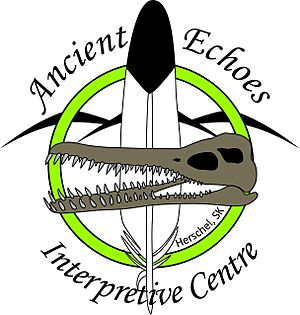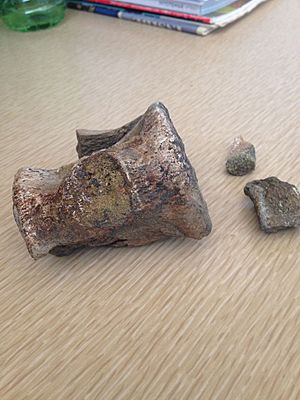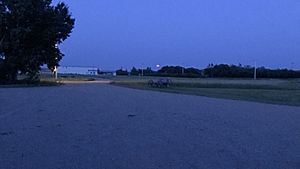Ancient Echoes Interpretive Centre facts for kids
The Ancient Echoes Interpretive Centre is a special museum and learning place in Herschel, Saskatchewan, Canada. It started in 1994. The centre teaches people about the history of the land, its people, and the Eagle Creek Valley. It also helps protect the important natural and historical sites in the area.
Discover Ancient Echoes
The Ancient Echoes Interpretive Centre is located in the village of Herschel, northwest of Rosetown. It is a community project that helps the west-central part of Saskatchewan. The centre is built on top of the Coalmine Ravine. From here, you can see several fossil beds and a special First Nations ceremonial site. This site is recognized as a Municipal Heritage Site by the province. Over the years, many professional archaeologists and paleontologists have dug here.
Ancient Echoes focuses on three main areas. These are the prehistoric era, the history of Aboriginal peoples, and the local environment. The area has important Aboriginal historical sites, including ancient rock carvings called petroglyphs. There are also places where archaeologists and paleontologists dig. They have found many marine fossils, like plesiosaurs and mosasaurs. The centre even has the only known example of a Dolichorhynchops herschelensis in the world.
You can take guided walks through the ravine. On these walks, you can see different sites and exhibits. The centre has displays about natural history and Aboriginal artifacts. There is also a permanent collection of paintings by Jo Cooper. These paintings tell the story of the plains bison.
Outside the centre, there is a life-size statue of a plains grizzly bear. These bears used to live on the prairie but disappeared in the early 1900s. The centre also remembers James Carnegie, 9th Earl of Southesk. He came to Saskatchewan in 1859 from Scotland. He was on a hunting trip looking for large animals, including the plains grizzly. His diary describes seeing a bear near Herschel.
Learning Programs and Visits
Ancient Echoes is a popular place for school trips. They offer special programs for students of all ages. These programs cover Aboriginal history, ecology, and archaeology. The centre also has summer programs. These include making traditional pottery and drums. You can also go on ecology and paleontology hikes. There are even full-moon hikes and craft days for children.
The centre is open from May to the end of August, Tuesday to Sunday. During the winter and spring, you can visit by asking ahead.
A Look Back: History of the Centre
In October 1994, the Herschel Interpretive Centre officially opened. It was run by dedicated volunteers. Money came from donations and a small government grant. The centre's goal was to explain, protect, and promote the history of the Eagle Creek Valley.
Over the years, Ancient Echoes has received many generous gifts. Local taxidermist Lyle Waddington donated several stuffed animals. These included many native birds and mammals found in the Herschel area. He also gave a full 900-kilogram buffalo mount. This buffalo is still on display today.
Around the same time, woodcarver Jack Klemmer visited the centre. His carvings have been shown there ever since. The money from selling his carvings goes to Ancient Echoes. In the late 1990s, Enbridge Pipelines donated $5,000. This money helped buy carts for displays. It also helped print the first copies of Jo Cooper's paintings. Her art, called “The Disappearance and Resurgence of the Buffalo,” is now a permanent exhibit at Ancient Echoes.
In the 1990s, the fossilized remains of three Dolichorhynchops herschelensis were found in the Coalmine Ravine. During this dig, paleontologists found many marine fossils. These included several shark species, fish bones, and a mosasaur. Since then, paleontologists have continued exploring the ravine. New dinosaurs, marine reptiles, plants, and other fossils are often found. The Herschel area is now known as a great spot for archaeology, paleontology, and finding native plants and animals.
Important Dates
- 65 million years ago – The Herschel area was covered by the Western Interior Seaway. This was a large saltwater sea. Many kinds of fossils were left on the seabed.
- 1960 – Henry Kosloski, a farmer, discovered Petroglyph #1. He kept it a secret to protect it.
- 1961 – The Herschel school, which later became Ancient Echoes, was built.
- 1978 – Kosloski shared his secret about the petroglyphs.
- 1988 – The petroglyph site became a provincial heritage site.
- 1990 – The first fossilized plesiosaur was found in the Herschel area. It was about 40 feet long.
- 1992 – Early digs happened at the petroglyph site. They found tools and pottery pieces.
- 1993 – More digs at the petroglyph sites found objects believed to be offerings. This showed the site was used from about 600 AD to 1900 AD.
- 1994 – The first plesiosaur was dug up and moved to the Royal Tyrrell Museum in Drumheller, Alberta. The Herschel school closed. The Herschel Development Committee bought the school for $1. The Herschel Interpretive Centre officially opened.
- 1996 – Jo Cooper, a Metis artist, came to work on her art show. It was called "The Disappearance and Resurgence of the Plains Buffalo."
- 1997 – Two more plesiosaurs were found. Paleontologists also found shark species, fish bones, and a mosasaur. Jack Klemmer donated money from his wood carvings. Cooper's paintings were displayed.
- 1998 – The community decided to buy Cooper's paintings for a permanent display. They raised money by selling wood from the town's old elevator.
- 1999 – The centre received a $5,000 donation from Enbridge Pipelines.
- 2005 – The plesiosaur remains were identified as a new species, Dolichorhynchops herschelensis. This was done by Dr. Tamaki Sato.
- 2016 – More paleontology work found new dinosaurs and marine reptiles in the ravine.
- 2017 – Ancient Echoes celebrated Canada 150 with "The Shared Land Celebration."
- 2018 – A visitor found a dinosaur bone. The centre reported it to the Royal Saskatchewan Museum.
- 2018 – The centre won the Prince of Wales Ecclesiastical Insurance Cornerstone Award. This award recognizes organizations that help their community over a long time.
Dolichorhynchops herschelensis: A Unique Discovery
The Ancient Echoes Interpretive Centre is home to the only known examples of Dolichorhynchops herschelensis. Dr. Tamaki Sato identified it as a new species in 2005. The fossils were found in the Bearpaw Formation in Saskatchewan. This rock formation dates back to the Late Cretaceous period. The fossil was found near Herschel, which is how the species got its name. The rocks here were formed in the Western Interior Seaway.
The D. herschelensis skeleton was found scattered around the dig site. The skull, lower jaw, ribs, pelvis, and shoulder blades were all found. However, the spine was not complete. So, we don't know the exact number of vertebrae the animal had. All four limbs are missing, except for a few small finger bones.
Scientists believe this fossil is from an adult Dolichorhynchops herschelensis. It was likely smaller than its close relative, D. osborni. Some young D. osborni were even bigger than this adult D. herschelensis. Scientists estimate the animal was about 2.5 to 3 meters long. It had a long, thin snout with many tooth sockets. However, only a few of its thin, sharp teeth remain.
What You Can See: Permanent Exhibits
Ancient Echoes Interpretive Centre offers indoor and outdoor tours. You can explore paleontology sites and exhibits. These include dinosaur and fossil displays, and geological specimens. There's also a dinosaur dig site.
The centre's prairie grasslands exhibit shows endangered prairie plants. It also teaches about traditional First Nations medicine and food. You can see displays of local animals and taxidermy. The First Nations exhibit covers their history in the Herschel area. Tours include a traditional ceremonial complex. This complex has petroglyphs, a vision quest site, and a turtle effigy. There are also archaeological dig sites, tipi rings, a buffalo jump, and places where pemmican was made. You can see tool artifacts and pottery displays. Exhibits also include items related to James Carnegie, 9th Earl of Southesk's visit in 1859.
The centre also has an art exhibit by Metis artist Jo Cooper. It's called “The Disappearance and Resurgence of the Buffalo.” This art explores the history of the plains bison in the region. Outside, there is a life-sized sculpture by William Epp. It shows the extinct plains grizzly bear. This bear was shot near the centre by Scottish hunter James Carnegie, 9th Earl of Southesk in 1859. You can also see a unique metal sculpture of a Dolichorhynchops herschelensis.
Changing Displays: Rotating Exhibits
Ancient Echoes has an art gallery space called the Prairie View Gallery. It features many exhibits throughout the year. These shows celebrate new and established artists and photographers. Exhibits usually stay at the centre for three months.
One past exhibit was "From Heartbreak to Healing" (2018). This show by Saskatchewan artist Jean A. Humphrey explored her experience with her husband's Alzheimer's disease. It included sculptures and paintings.
The Valley View Tea and Craft Room
The Valley View Tea Room is inside Ancient Echoes Interpretive Centre. Local volunteers run it. They offer coffee, tea, and other drinks. They also have homemade baked goods, like local Saskatoon berry pie. The centre's gift shop sells souvenirs for kids and adults. These items are related to Ancient Echoes and the Herschel community.
The tea room is open Wednesdays, Fridays, and Sundays from 2:30-4:30 P.M. CST during the summer. In the winter, it is open on Fridays.
The Herschel Museum
The Herschel Museum is located in the old St. Boniface Catholic Church. This church was built in 1926. It closed in 1969. The building was later sold and given to the Village of Herschel in 1988. That's when it officially opened as the Herschel Museum.
The museum shows what a local kitchen, living room, and bedroom looked like in the past. It also has household items. Souvenirs from the Herschel School are collected here. School photos are displayed in an album at Ancient Echoes. There is a large collection of local sports items, tools, and farm equipment. The Rural Municipality of Mountain View No. 318 also has books, maps, and artifacts on display.
You can only visit the Herschel Museum through the Ancient Echoes Interpretive Centre. They offer educational programs and guided school tours. These tours focus on history, nature, First Nations culture, paleontology, and archaeology. School groups from the local area and Saskatoon often visit in the spring and summer.





